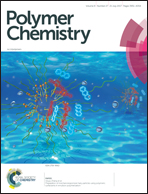Synthesis of conjugated copolymers by combining different coupling reactions†
Abstract
Despite the significant progress in the controlled synthesis of conjugated polymers using a Catalyst Transfer Condensative Polymerization, the possibilities regarding random and gradient copolymers remain very limited. Therefore, a novel concept is introduced, in which different organometallic functions are placed on the monomers in a copolymerization, meaning that different types of coupling reactions are combined. By using combinations of Grignard, organozinc, organoboron, organotin and organogold functional groups, the goal is to tune the reactivity ratio of the monomers. As such, it enables to tune the polymer structure without having to intervene during the polymerization, something which was impossible up to now. In this study, two randomly copolymerizing thiophene monomers are considered, whose reactivity is varied by altering the organometallic function. Despite the significant difference in reactivity between the chosen functional groups, it is found that most combinations nevertheless result in the formation of a random copolymer. However, the combination of the organotin and organogold monomer shows a gradient in the monomer consumption, with a preferential incorporation of the organogold monomer at low conversion. Although the copolymerization is not controlled, it is an indication that the use of different organometallic functions is a viable strategy to tune the gradient in a copolymerization.



 Please wait while we load your content...
Please wait while we load your content...